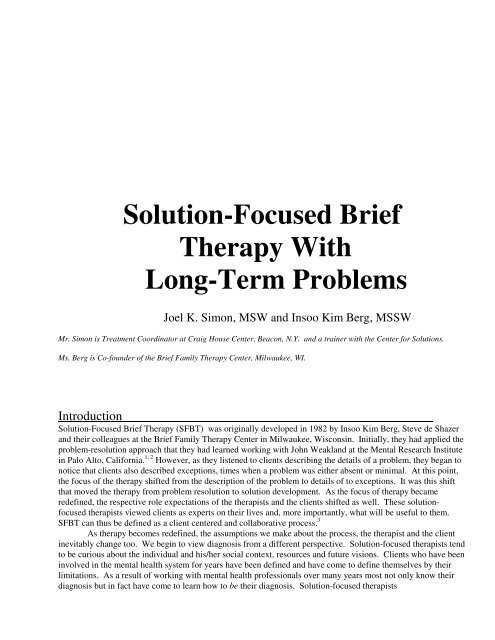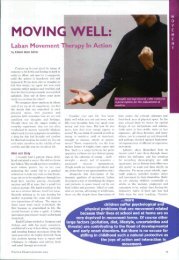Solution-Focused Brief Therapy With Long-Term Problems
Solution-Focused Brief Therapy With Long-Term Problems
Solution-Focused Brief Therapy With Long-Term Problems
You also want an ePaper? Increase the reach of your titles
YUMPU automatically turns print PDFs into web optimized ePapers that Google loves.
<strong>Solution</strong>-<strong>Focused</strong> <strong>Brief</strong><br />
<strong>Therapy</strong> <strong>With</strong><br />
<strong>Long</strong>-<strong>Term</strong> <strong>Problems</strong><br />
Joel K. Simon, MSW and Insoo Kim Berg, MSSW<br />
Mr. Simon is Treatment Coordinator at Craig House Center, Beacon, N.Y. and a trainer with the Center for <strong>Solution</strong>s.<br />
Ms. Berg is Co-founder of the <strong>Brief</strong> Family <strong>Therapy</strong> Center, Milwaukee, WI.<br />
Introduction<br />
<strong>Solution</strong>-<strong>Focused</strong> <strong>Brief</strong> <strong>Therapy</strong> (SFBT) was originally developed in 1982 by Insoo Kim Berg, Steve de Shazer<br />
and their colleagues at the <strong>Brief</strong> Family <strong>Therapy</strong> Center in Milwaukee, Wisconsin. Initially, they had applied the<br />
problem-resolution approach that they had learned working with John Weakland at the Mental Research Institute<br />
in Palo Alto, California. 1, 2 However, as they listened to clients describing the details of a problem, they began to<br />
notice that clients also described exceptions, times when a problem was either absent or minimal. At this point,<br />
the focus of the therapy shifted from the description of the problem to details of to exceptions. It was this shift<br />
that moved the therapy from problem resolution to solution development. As the focus of therapy became<br />
redefined, the respective role expectations of the therapists and the clients shifted as well. These solutionfocused<br />
therapists viewed clients as experts on their lives and, more importantly, what will be useful to them.<br />
SFBT can thus be defined as a client centered and collaborative process. 3<br />
As therapy becomes redefined, the assumptions we make about the process, the therapist and the client<br />
inevitably change too. We begin to view diagnosis from a different perspective. <strong>Solution</strong>-focused therapists tend<br />
to be curious about the individual and his/her social context, resources and future visions. Clients who have been<br />
involved in the mental health system for years have been defined and have come to define themselves by their<br />
limitations. As a result of working with mental health professionals over many years most not only know their<br />
diagnosis but in fact have come to learn how to be their diagnosis. <strong>Solution</strong>-focused therapists
Simon & Berg SFBT <strong>With</strong> <strong>Long</strong> <strong>Term</strong> <strong>Problems</strong> Page 2<br />
__________________________________________________________________________________________<br />
are interested in what people do to make their<br />
lives better, not in how their diagnoses or their<br />
problems limit them. In practice, therefore,<br />
SFBT seeks to expand individual possibilities.<br />
Basic Approaches of SFBT<br />
<strong>Solution</strong> <strong>Focused</strong> <strong>Therapy</strong> challenges the<br />
assumptions of conventional theories of<br />
psychotherapy. As the original assumptions were<br />
questioned and to a large extent, abandoned, new<br />
assumptions replaced them.<br />
Basic Assumptions:<br />
The set of assumptions that inform solutionfocused<br />
practice:<br />
1. Change is constant and inevitable;<br />
2. Small changes result in bigger changes;<br />
3. Since you can't change the past,<br />
concentrate on the future;<br />
4. People have the resources necessary to<br />
help themselves: they are the experts;<br />
5. Every human being, relationship and<br />
situation<br />
is unique;<br />
6. Everything is interconnected;<br />
7. Every problem has at least one<br />
exception;<br />
8. <strong>Therapy</strong> is not the only way people<br />
change, there are many things that are<br />
therapeutic (p. 79).<br />
The application of these assumptions redefines<br />
therapy in many different ways. The<br />
therapist/client relationship is de-emphasized.<br />
Instead, the focus is on what clients do outside of<br />
the therapy office that is helpful and moves them<br />
toward realizing their goals for therapy. Thus,<br />
instead of “talking about living a life,” we focus<br />
on “living a life.” As opposed to the medical<br />
model that assumes that problems are within the<br />
individual, SFBT contextualizes solutions<br />
socially. <strong>Solution</strong>s arise from the individual’s<br />
social context and as a result of personal and<br />
social resources. This way of thinking offers<br />
more flexibility in developing solutions.<br />
Many clients experience their problems as the<br />
status quo. Our experience tells us that status quo<br />
is illusionary and that exceptions are already<br />
happening. A study done by Weiner-Davis, de<br />
Shazer and Gingerich5 surveyed 30 clients and<br />
found that 66% reported positive, pretreatment<br />
change. In describing this study, Miller and<br />
colleagues 11 state:<br />
. . . The studies conducted to date clearly indicate<br />
that beneficial change can and frequently does<br />
occur prior to the initiation of formal treatment.<br />
For example, change due to the operation of<br />
chance events or client strengths may be partly<br />
responsible for approximately 40% of clients who<br />
improve enough not to need treatment on a<br />
waiting list for services. pp.42<br />
It becomes the therapist’s job to redirect the<br />
client’s attention to useful exceptions.<br />
<strong>Brief</strong> Versus Short <strong>Term</strong><br />
<strong>Solution</strong>-focused therapy is a brief approach.<br />
There is often confusion between short-term and<br />
brief therapy and often the terms are used<br />
interchangeably. Conceptually, they are very<br />
different. 6 In general, short-term therapy uses<br />
time as a motivator of progress. In short-term<br />
therapy, there is a specific time frame, usually<br />
expressed in the total number of sessions. The<br />
short term therapist will explain to the client that<br />
he or she has a certain number of session, days or<br />
weeks in which to the necessary work.<br />
<strong>Brief</strong> therapy is focused on goals. The therapist<br />
works with clients to define specific goals and<br />
once they are well on their way to accomplishing<br />
their goals, therapy is, by definition, completed.<br />
Steve de Shazer, in the introduction to Yvonne<br />
Dolan's book, 7 states, "'<strong>Brief</strong> therapy' simply<br />
means therapy that takes as few sessions as<br />
possible, not even one more than is necessary, for<br />
you to develop a satisfactory solution" (p. x).<br />
The First <strong>Solution</strong>-<strong>Focused</strong> Session:<br />
There are two functions that are<br />
accomplished simultaneously in the first solutionfocused<br />
session: development of an initial goal<br />
and initiation of the solution building process. As<br />
previously stated, well-defined goals are keys not<br />
only for keeping therapy brief, but also to ensure a
Simon & Berg SFBT <strong>With</strong> <strong>Long</strong> <strong>Term</strong> <strong>Problems</strong> Page 3<br />
__________________________________________________________________________________________<br />
successful outcome. Insoo Kim Berg and Scott<br />
Miller 8 detail seven qualities comprising wellformed<br />
goals:<br />
1. Saliency to the Client<br />
2. Small<br />
3. Concrete, Specific and Behavioral<br />
4. The Presence Rather than the<br />
Absence of Something<br />
5. A Beginning Rather Than an End<br />
6. Realistic and Achievable <strong>With</strong>in the<br />
Context of the Client's Life<br />
7. Perceived as Involving "Hard Work"<br />
(pp. 32-43).<br />
The Six Questions<br />
The questions that the therapist uses to negotiate<br />
the goal with the client simultaneously help move<br />
the client into a solution-building process.<br />
<strong>Solution</strong>-focused therapists use six questions that<br />
have been developed collaboratively with clients. 9<br />
We have found it helpful to ask the client about<br />
pre-session change. 3,8,9 For example, we might<br />
ask, “Between the time you called to set up this<br />
appointment and today, what is it that you’ve<br />
noticed that is already a little bit better?”<br />
Research data 5 suggests that a high percentage of<br />
clients will answer pre-session change questions<br />
substantively.<br />
When a client is able to provide details of<br />
pre-session improvement, it facilitates solutionbuilding<br />
in several ways. First, it provides the<br />
therapist and client with clues of the goal. There<br />
is high probability that the client need only to<br />
continue and increase what is already happening.<br />
Second, it moves the conversation from the<br />
exploration of the problem to the building of a<br />
solution. We’ve found that when clients begin to<br />
perceive expanded possibilities, they more quickly<br />
begin to develop useful solutions. Pre-session<br />
change questions move the client in that direction<br />
of possibilities and goals simply and effectively.<br />
If clients are unable to delineate presession<br />
change, or are unclear about how they will<br />
know that their problem is solved, we will usually<br />
ask them about their vision of a better future, 3,8,9<br />
the second type of useful question. Asking an<br />
individual about the details of how things will be<br />
better including how others in the social<br />
environment will notice the improvement, is an<br />
effective way of helping the client begin<br />
constructing a solution picture. For example, we<br />
might ask, “Suppose, your meeting with me today<br />
is helpful. What will be the first sign to you that<br />
things are different?”<br />
Once the client begins to develop a<br />
solution picture, solution-focused therapists then<br />
ask the Miracle Question: 7<br />
Suppose that one night (pause) , while you<br />
are asleep, there is a miracle and the<br />
problem that brought you into therapy is<br />
solved (pause). However, because you<br />
are asleep you don't know that the miracle<br />
has already happened (pause). When you<br />
wake up in the morning, what will be<br />
different that will tell you that the miracle<br />
has taken place? What else? (p. 13).<br />
The Miracle Question was developed at<br />
the <strong>Brief</strong> Family <strong>Therapy</strong> Center in 1983 and<br />
actually suggested by a client to Insoo Kim Berg.<br />
It continues and expands upon the solution<br />
picture. More importantly, it minimizes “problem<br />
talk.” Steve de Shazer 1 addresses this point,<br />
All the miracle question is designed to do<br />
is to allow clients to describe what it is<br />
they want out of therapy without having to<br />
concern themselves with the problem and<br />
the traditional assumptions that the<br />
solution is somehow connected with<br />
understanding and eliminating the<br />
problem (p. 273).<br />
The immediate visible reaction by clients<br />
to the miracle question is that they sit back in the<br />
chair and become thoughtful and relaxed. The<br />
therapist needs to allow clients a considerable<br />
amount of silence for introspection since this is a
Simon & Berg SFBT <strong>With</strong> <strong>Long</strong> <strong>Term</strong> <strong>Problems</strong> Page 4<br />
__________________________________________________________________________________________<br />
new experience for most of them. Even with<br />
careful pacing and connecting with clients, the<br />
common immediate response frequently begins<br />
with, “I don’t know. . . I suppose, I will be calmer,<br />
relaxed . . . like I could face the day. . .” It is<br />
important to track the client’s solution picture in<br />
detail.<br />
In the course of asking solution-building<br />
questions, quite often the client will raise<br />
exceptions, times that the problem either is<br />
experienced as less significant or absent entirely.<br />
When the therapist hears this, it is usually helpful<br />
to expand on exceptions. 3,8,9 In the course of<br />
discussing the Miracle Question, solution-focused<br />
therapists might ask the client about exceptions<br />
directly. For example, “What part of the miracle<br />
is already happening?”<br />
Once the client details his or her miracle<br />
picture, the solution-focused therapist will ask a<br />
Scaling Question. 3,8,9 Scaling Questions not only<br />
help the client to recognize exceptions, but begin<br />
the process of defining the “next steps.” The<br />
typical scaling question requests the person to<br />
place oneself on a scale from 0 to 10, where 0 is<br />
the least desired condition, and 10 is the most<br />
desired outcome. Scaling possibilities are<br />
unlimited and many different types of scales can<br />
be used: for example, miracle day scales,<br />
confidence scales, motivation scales, or even<br />
safety scales. Scaling possibilities are limited<br />
only by the therapist’s creativity and the<br />
applicability to the client.<br />
When using scales, the solution-focused<br />
therapist will discuss what the particular number<br />
means to the client. The question is always in<br />
terms of how the client got up to the number on<br />
the scale rather than why the number is not higher.<br />
For example, if a client tells us that he or she is at<br />
3 on the scale, we might ask, “How is 3 different<br />
from 0,” or, “How did you go all the way up to<br />
3?”<br />
After the meaning of the specific scale<br />
number is negotiated, the solution-focused<br />
therapist will then ask how the client will know<br />
when he or she is just one number higher on the<br />
scale. This next step is discussed in detail; we<br />
want to know what will be different for the client<br />
and how other people will know when the next<br />
step is reached. We also ask what difference that<br />
next step t will make for the client as well as<br />
others within his or her social environment.<br />
Pre-session, vision of the future, miracle,<br />
exception and scaling questions will be useful<br />
with the majority of clients. Occasionally, a<br />
client may have initial difficulty thinking beyond<br />
the problem situation and is unable to shift into a<br />
solution-building context. At these time, we find<br />
it useful to ask clients coping questions. 3,8,9 For<br />
example, “Given everything you have told me<br />
about what’s going on in your life, how do just<br />
make it through each day?” We find that most<br />
often the client will respond with a strength based<br />
response. The solution-focused therapist can then<br />
expand on that response. For example, in<br />
response to a coping question the client might say,<br />
“My mother taught me how to be strong.” The<br />
therapist would respond, “What would your<br />
mother see you doing now that would tell her that<br />
you’re being strong?”<br />
As solution-focused therapists, we employ<br />
the six questions appropriately in order to gauge<br />
the client’s response. To be truly helpful to the<br />
client, the therapist must practice careful listening.<br />
We find it most helpful to weave our next<br />
questions in response to the client’s key words.<br />
For example, when a client says, “I won’t be<br />
ashamed of myself anymore,” we might use the<br />
client’s key words and ask, “So, when you are no<br />
longer ashamed, what would you feel instead?”<br />
As the therapist develops listening skills to<br />
facilitate this kind of conversation, he or she<br />
begins to become aware of a wealth of<br />
possibilities, each one having the potential of<br />
moving the session in useful ways. The therapist<br />
needs to really listen to what the client says and<br />
not assume anything.<br />
At this point in the session, the therapist<br />
will take a break. If working with a group of<br />
colleagues behind a one-way mirror or video<br />
monitor, the therapist will discuss the client. If<br />
working alone, he or she will take time to think<br />
about what the client said during the interview.<br />
When the session resumes, the therapist will relate<br />
what he or she and/or the team thinks. Campbell,<br />
Elder, Gallagher, Simon, and Taylor 10 characterize<br />
the message as compliments. The authors<br />
summarize this compliment process:<br />
The compliments usually include<br />
validation of concerns, recognition of
Simon & Berg SFBT <strong>With</strong> <strong>Long</strong> <strong>Term</strong> <strong>Problems</strong> Page 5<br />
__________________________________________________________________________________________<br />
competencies, and a suggestion for<br />
something to do between sessions (pp. 3-<br />
4).<br />
Between-session suggestions are designed<br />
appropriate to the client’s motivation for change. 11<br />
For example, for clients who are highly motivated,<br />
we might suggest they choose 2 or 3<br />
nonconsecutive days during which they act as if<br />
the miracle had happened. Those clients who are<br />
less motivated might be asked to report on what<br />
they noticed has moved them up one point on the<br />
scale. Those clients who are referred by a third<br />
party (e.g., a probation officer, Department of<br />
Social Services, or Child Protective Services) and<br />
who have no clearly defined goals are not often<br />
given between-session suggestions. The attempt<br />
in any between-session suggestion is to match the<br />
suggestion to the client’s motivation to insure a<br />
higher probability of completion. 11<br />
Subsequent <strong>Solution</strong>-<strong>Focused</strong> Sessions:<br />
Scheduling of subsequent sessions is<br />
decided at the end of each session. This is<br />
different from the traditional custom of scheduling<br />
weekly sessions. Clients will make the decision of<br />
when they want to return, and most choose to wait<br />
2 or 3 weeks. In addressing return visits, the<br />
therapist’s interest is that the client has enough<br />
time to think about and use the between-session<br />
suggestion.<br />
We have found it helpful to begin<br />
subsequent sessions with a scale. The session is<br />
then naturally built around signs of progress and<br />
possible next steps. Berg and DeJong 3 present a<br />
useful way of expanding on the solution-building<br />
process in subsequent sessions:<br />
Insoo and her colleagues at BFTC have<br />
spent many years working out new and<br />
more effective ways to do this. They have<br />
developed the acronym EARS to capture<br />
the interviewer’s activities in this work. E<br />
stand for eliciting the exception. A refers<br />
amplifying it, first by asking the client to<br />
describe what is different between the<br />
exception time and problem times and<br />
second by exploring how the exception<br />
happened. . . R involves reinforcing the<br />
successes and strengths that the exception<br />
represents. . . Lastly, the S reminds<br />
interviewers to start again, by asking,<br />
“And what else is better?” (pp. 136-137).<br />
Application of <strong>Solution</strong>-<strong>Focused</strong><br />
<strong>Therapy</strong><br />
The strengths of the solution-focused approach<br />
are its flexibility and adaptability. If one question<br />
does not prove particularly useful, most likely<br />
another will be worth the therapist’s attention.<br />
Since there are unlimited ways that solutionfocused<br />
therapists have of asking the six useful<br />
questions, the approach can be adapted to a<br />
diverse clientele. Following is a case presentation<br />
which will demonstrate the approach’s usefulness<br />
with an individual who has spent many years<br />
using community mental health services.<br />
Case Example:<br />
Client Background<br />
Steven is 40 years old. According to the<br />
record, he has had a history of psychiatric<br />
problems from early childhood. His first<br />
hospitalization was at the state psychiatric center<br />
at age 17. Since then he has had multiple<br />
hospitalizations in community hospital mental<br />
health units as well as the state psychiatric center.<br />
The average hospital stays were of relatively long<br />
duration lasting from 3 to 8 weeks. There are 4<br />
psychiatric evaluations, completed by separate<br />
psychiatrists, that represent the past 6 years. Each<br />
of those psychiatrists has diagnosed Steven as<br />
schizophrenic, undifferentiated type, and chronic.<br />
During the course of his years in mental health, he<br />
has been on a variety of psychiatric medications,<br />
many of which he complained produced side<br />
effects.<br />
Steven was referred to Community<br />
Counseling at Goshen in May 1996 by another<br />
outpatient, community mental health clinic.<br />
Several weeks prior to his referral, the psychiatrist<br />
had written:
Simon & Berg SFBT <strong>With</strong> <strong>Long</strong> <strong>Term</strong> <strong>Problems</strong> Page 6<br />
__________________________________________________________________________________________<br />
Patient complains of swollen tongue.<br />
Will discontinue [the medication].<br />
Moreover he has been giving variable<br />
complaints, verbalizing suicidal<br />
ideation, then retracting it. Now<br />
complains of insomnia. I believe he is<br />
malingering for attention.<br />
This final psychiatric note was filed:<br />
Steven, as is usual, now requests a<br />
return to [name of medication] several<br />
weeks after he requested to have [same<br />
medication] changed as ineffective.<br />
Things are going round and round with<br />
no progress. His family reports that he<br />
lies and should not be believed. This<br />
however leaves open the question of how<br />
to track him. . .<br />
<strong>Solution</strong>-<strong>Focused</strong> <strong>Brief</strong> <strong>Therapy</strong><br />
Treatment Process<br />
Steven was first seen at Community Counseling at<br />
Goshen in mid-June 1996. The therapist is Joel<br />
Simon. All therapy sessions used a one-way<br />
mirror and a consultation team. The following<br />
process summary represents approximately 30<br />
sessions over the course of 2 years. Each session<br />
lasted approximately 1 hour, and the average<br />
length of time between sessions was 3 weeks.<br />
Initially Steven was asked what he wanted<br />
from coming to therapy. He responded that he<br />
wanted to “get help with schizophrenia.” When<br />
asked how he would know that he was getting that<br />
help, he said that he would be more outspoken<br />
with people. This was expanded on when the<br />
Miracle Question was asked.<br />
During the course of the miracle question,<br />
Steven spoke about what was already helpful to<br />
him in his life. He said that his current medication<br />
helps to prevent hallucinations. When he was<br />
asked how he helps the medication to work,<br />
Steven presented a wide variety of helpful<br />
activities: taking long walks, praying, and being<br />
with his friends and family.<br />
Steven was then asked to scale himself<br />
where 10 is being on track, and 0 the opposite. He<br />
responded that he was at 10. When asked to<br />
assess himself on a scale where 10 is not needing<br />
therapy to continue this progress, and 0 is needing<br />
therapy, he responded that he was at 0.<br />
After the break, the team had many<br />
compliments for Steven, including his hard and<br />
his knowledge of what is helpful to him. They<br />
suggested that he take notice of what he does that<br />
keeps him on track.<br />
Steven returned 4 weeks later, still<br />
reporting that he was on track. He reported that<br />
he was calmer and his family was noticing this.<br />
He continued to do those things that he previously<br />
reported as helpful. Once again, he gave much<br />
credit to the medications he was taking. The<br />
therapist asked him what percent of his success<br />
was due to the medications and what percent his<br />
hard work? Steven responded that 10% was the<br />
medication and 90% was his work. Steven<br />
expressed an interest in returning to a work<br />
program that had not been successful for him<br />
previously. The team validated his hard work and<br />
expressed how impressed they were about the<br />
program that he has developed for himself to stay<br />
on track. They suggested that he take notice of<br />
what shows him that he’s ready for the work<br />
program.<br />
Steven returned 1month later and reported<br />
that his father, who had been very ill with cancer,<br />
died during this period. When the therapist asked<br />
Steven what he had been doing that was helpful in<br />
dealing with his father’s death, he reported that his<br />
friends and family had been supportive. He felt<br />
better and had reached some of his goals before<br />
coming to the counseling center this time. He said<br />
again that he is ready to return to the work<br />
program and explained what he noticed that told<br />
him that he was ready to return.<br />
During the course of the next few<br />
sessions, Steven met with staff from the work<br />
program and presented to them in an articulate and<br />
logical manner, why he felt he was ready to return<br />
to the program. Unfortunately, because of their<br />
previous negative experience with him, they<br />
turned him down. He was understandably<br />
disappointed but was willing to accept an<br />
alternative training program.<br />
In the next several months, Steven<br />
attended the job-training program regularly and<br />
the supervisor reported that he was on time and<br />
responsible. Steven opted not to go into the next<br />
phase of the training and instead decided to attend<br />
a psychosocial club (River Club) close to where
Simon & Berg SFBT <strong>With</strong> <strong>Long</strong> <strong>Term</strong> <strong>Problems</strong> Page 7<br />
__________________________________________________________________________________________<br />
he lives. He was able to provide an intelligent<br />
rationale for his decision.<br />
As of this writing, Steven continues to<br />
attend the program, has made many friends, and<br />
speaks with excitement of his experiences there.<br />
Recently, he has become involved in a job-training<br />
program associated with the club. He has wisely<br />
built a network of social supports that includes his<br />
family, his church and the staff and members of<br />
River Club.<br />
Steven experienced several important<br />
events during the course of his work with<br />
solution-focused therapy. His father, with whom<br />
he was very close, died in late 1996. Steven<br />
signed himself into a local community hospital<br />
mental health unit in December 1996. He stated<br />
that he was feeling depressed since As previously<br />
stated, during the past two years, Steven’s total<br />
hospital days had decreased dramatically to<br />
a day and a half. This despite several major life<br />
stressors: the death of his father, the death of his<br />
mother, change of residence, being denied a job<br />
training program, and having to cope with a minor<br />
legal situation (he was arrested for harassment).<br />
Building <strong>Solution</strong>s<br />
In November 97, Steven reported that he talked to<br />
his psychiatrist about having auditory<br />
hallucinations. The psychiatrist suggested he<br />
discuss this with his therapist. Following is an<br />
example of how solution-focused therapists use<br />
questions in the solution-building manner. Notice<br />
how the therapist is selective about what he pays<br />
attention to, what he does not, and how he phrases<br />
questions.<br />
In the course of introducing the topic,<br />
Steven said, “It happens most of the day. When I<br />
go to River Club, I don’t hear it.”<br />
Therapist: So when you’re at River<br />
Club, you don’t hear it.<br />
Steven: When I’m here, I don’t hear it<br />
either.<br />
Therapist: What’s different at River Club,<br />
what’s different here?<br />
Steven: I also don’t hear it in church.<br />
Therapist: So what’s different here,<br />
River Club and church?<br />
Steven: At River Club there’s noise<br />
that blocks it out. Same thing in<br />
church. When I’m alone I hear itit’s<br />
scary. I asked my mom whether<br />
she hears it. She told it’s probably<br />
in my mind.<br />
Therapist: What told you to ask your<br />
mom? That’s impressive! You did an<br />
experiment-you did some research.<br />
Steven: (Laughs) Yeah, I asked my mom.<br />
Therapist: How did you figure out how to<br />
do that?<br />
Steven: I wanted to make sure it wasn’t<br />
something going on in the whole family.<br />
My sister said she didn’t hear it, my mom<br />
said she didn’t hear it.<br />
Therapist: Once you found out it wasn’t<br />
real, how did that change things for you?<br />
Steven: It’s still kind of scary. I know it’s<br />
not real.<br />
Therapist: That’s helpful?<br />
Steven: It helps relieve some of the<br />
scariness.
Simon & Berg SFBT <strong>With</strong> <strong>Long</strong> <strong>Term</strong> <strong>Problems</strong> Page 8<br />
__________________________________________________________________________________________<br />
Therapist: What other times at your<br />
house you don’t hear it?<br />
Steven: I don’t hear it during the day, only at<br />
night.<br />
Therapist: What’s different during the day?<br />
Steven: During the day, I’m busy. My mind is on<br />
other things.<br />
Therapist: So, when you’re busy, your mind is on<br />
other things<br />
.<br />
Steven: Only when I’m by myself and alone, I<br />
hear it.<br />
Therapist: If I had a scale where 10 is it only<br />
happens at night. It’s really not scary and<br />
you can ignore it and 0 is the opposite, where<br />
would you put yourself right now?<br />
Steven: I’d say 5. I control it a little bit, not<br />
much.<br />
Therapist: How do you control it?<br />
Steven: Take my medicine on time. Eat right-I’m<br />
diabetic. That has something to do<br />
with it.<br />
Therapist: How’s the medicine help?<br />
Steven: Which one? For diabetes or my<br />
Schizophrenia?<br />
Therapist: Either one.<br />
Steven: It stabilizes me; keeps me calm and I<br />
sleep well.<br />
Therapist: And controlling your diet, how is that<br />
helpful?<br />
Steven: If I eat well. . . If I drink coffee, I hear it<br />
more. So I cut down on coffee.<br />
Therapist: What else gets you to 5?<br />
Steven: I pray a lot, that helps. I talk to people.<br />
When I get angry, I hear it even more.<br />
Therapist: So, how do you keep from getting<br />
angry?<br />
Steven: Go to River Club and talk to people there.<br />
Therapist: Since you’ve been doing that and<br />
getting less angry, what have you noticed is<br />
different?<br />
Steven: I haven’t been hearing it as much.<br />
Therapist: What else do you do to get to that 5?<br />
Steven: Look at my [car] models; sometimes I<br />
draw. I go to the library.<br />
Therapist: How are those things helpful?<br />
Steven: They help pretty good.<br />
Therapist: How would you know that six is<br />
happening?<br />
Steven: Keeping more active and controlling it<br />
more.<br />
Therapist: What about at night, how would you<br />
know 6 is happening then?<br />
Steven: Probably keeping busier-finding<br />
something to do to keep busy.<br />
Therapist: What could you do that would be<br />
helpful?<br />
Steven: Call a friend I could trust.<br />
Therapist: What else?<br />
Steven: Exercise, do sit ups. Read the Bible or<br />
books.<br />
Therapist: So, on a confidence scale where 10 is<br />
you’re really sure that these things will help and 0<br />
is the opposite, where are you?<br />
Steven: 10. The other thing is going to bed later.<br />
Therapist: You have lots of good ideas. How did<br />
you come up with them?
Simon & Berg SFBT <strong>With</strong> <strong>Long</strong> <strong>Term</strong> <strong>Problems</strong> Page 9<br />
__________________________________________________________________________________________<br />
Steven: That was what my dad said to do.<br />
Therapist: What other ideas did Dad have that are<br />
helpful to you?<br />
Steven: He said don’t think too much. Don’t sit<br />
around and daydream. Stay busy.<br />
At this point, I asked Steven to scale himself on<br />
an “on track” scale where 10 is on track and 0 is<br />
the opposite. He scaled himself at 10.<br />
Restructuring<br />
Campbell, et. al. 9 write about restructuring:<br />
Many clients have defined the<br />
problem in ways that limit solutions,<br />
e.g. chemical imbalance, abusive<br />
partners, misbehaving children or a<br />
diagnostic label. <strong>Solution</strong>-focused<br />
therapy uses questions to create<br />
awareness of options. Restructuring<br />
statements are effective tools in this<br />
process. . . While the team offers<br />
possible options for thinking<br />
differently, it is the client who actively<br />
restructures his or her own thinking<br />
(p. 7).<br />
The authors further clarify the definition<br />
of restructuring:<br />
Our use of this word is not related to<br />
a belief in a deeper psychic structure,<br />
but rather to how clients come to<br />
think differently about themselves and<br />
their problems (p. 7).<br />
We have found that clients who have been<br />
treated in conventional mental health services for<br />
many years, define themselves in ways that limit<br />
options. For example, they are told that they have<br />
an illness which needs to be managed, similar to<br />
diabetes. They need to maintain a minimum of<br />
stress, and to have “realistic” aspirations for<br />
themselves.<br />
In one particular poignant session, Steven<br />
spoke of his diagnosis, stating that he has an<br />
illness and knows that he is schizophrenic. Steve<br />
de Shazer 1 writes about this issue:<br />
“Schizophrenia” started out as the<br />
name of a concept and subsequently<br />
has become reified and thus is<br />
frequently read or interpreted as<br />
static, as not changing over time. The<br />
term is usually read to mean that cure<br />
is impossible: Only remission is<br />
possible and therefore relapse is<br />
always lurking around the corner (p.<br />
108).<br />
<strong>Solution</strong>-focused therapy co-constructs<br />
possibilities with the client. Diagnoses, especially<br />
diagnoses such as “schizophrenia,” imply<br />
disability. <strong>Solution</strong>-focused therapy focuses on<br />
what clients do to improve their situation.<br />
When the therapist had returned from<br />
consulting with the team, he said the following to<br />
Steven:<br />
Therapist: Well, we certainly had a<br />
lively discussion back there, Steven.<br />
I think the first thing we want to<br />
say is the only use we find in any<br />
diagnosis is that it gets us paid.<br />
We’ve worked with you a long time<br />
and have been impressed with how<br />
you think, how you’ve figured out<br />
how to make your life better and<br />
keep yourself on track. We don’t<br />
see you as your diagnosis. We just<br />
see you as Steven.<br />
Steven: That’s the first time anyone ever said that<br />
to me.<br />
It’s obvious from this brief excerpt to see how<br />
years in the conventional mental health system<br />
have served to, using de Shazer’s language, reify<br />
the diagnosis for Steven. As the sessions went by,<br />
Steven began to talk differently about himself; he<br />
began to report being able to see the normal things<br />
that he does. In one particular session Steven<br />
said, “I say I have more of a sound mind now.”<br />
Significantly, those who had known Steven for<br />
many years, those in varied mental health
Simon & Berg SFBT <strong>With</strong> <strong>Long</strong> <strong>Term</strong> <strong>Problems</strong> Page 10<br />
__________________________________________________________________________________________<br />
professional roles and his family, began to<br />
comment on the positive differences they were<br />
seeing.<br />
In April, 1998, Steven decided that he no<br />
longer needed to continue in therapy. As is the<br />
custom in Community Counseling at Goshen,<br />
Steven participated in a discharge interview:<br />
Interviewer: What happened here that was helpful<br />
to you?<br />
Steven: I first started coming June 17,1996. As<br />
soon as I started coming here, I started doing<br />
better. In the other therapy, they started getting<br />
too personal. I like coming here.<br />
Interviewer: Is there anything we missed or could<br />
have done better?<br />
Steven: No, everything was just right.<br />
Interviewer: Now’s your chance to scale [the<br />
therapist]. On a scale of zero to ten, where<br />
would you put him?<br />
Steven: 10<br />
Interviewer: What put him there?<br />
Steven: The way he expressed things. He helped<br />
me understand better.<br />
Interviewer: If a friend or family member asked<br />
you to describe what happened here,what would<br />
you tell them?<br />
Steven: When I first started coming, I was<br />
nervous. But, after a couple of weeks, started<br />
feeling really different. It helped out really good.<br />
They really helped me here.<br />
Interviewer: Any other comments?<br />
Steven: I made a lot of progress over the past two<br />
years.<br />
Conclusion<br />
Steven’s case demonstrates that the solutionfocused<br />
brief therapy approach will work with<br />
clients who have had long time involvement in the<br />
mental health system. In reviewing Steven’s<br />
progress for this lesson, the authors become very<br />
aware of the simple yet powerfully effective<br />
assumptions that guided the therapy. The<br />
therapist worked from the assumption of Steven’s<br />
competencies. The questions the therapist asked<br />
focused the client on the strategies and resources<br />
that he was developing during the course of their<br />
contacts. In general, the therapist’s interest was in<br />
what Steven was doing in between sessions that<br />
was helpful to him.<br />
Through the course of the therapy, Steven<br />
increasingly experienced his own empowerment.<br />
The therapy served simply to affirm the progress<br />
that had become more and more evident. What<br />
may in fact be the most helpful to our clients is<br />
working with therapists who know less and are<br />
willing to discover more about their patients. As<br />
solution-focused therapists, we have become<br />
increasingly curious about our clients’ strengths<br />
and resources. Careful listening driven by this<br />
curiosity and desire to discover more about our<br />
clients ultimately is most helpful to them.<br />
References<br />
1. de Shazer, Steve . Words Were Originally<br />
Magic. New York: W.W. Norton & Company;<br />
1994.<br />
2. de Shazer, S., Berg, I., Lipchik, et al. <strong>Brief</strong><br />
<strong>Therapy</strong>: <strong>Focused</strong> <strong>Solution</strong> Development. Family<br />
Process, 25, 207-221; 1986.<br />
3. DeJong, P. & Berg, I.K. Interviewing for<br />
<strong>Solution</strong>s. Pacific Grove, California:<br />
Brooks/Cole Publishing Company; 1998.<br />
4. Lipchik, Eve. Case Studies: Mr. Spock Goes to<br />
<strong>Therapy</strong>, Good <strong>Therapy</strong> Means Knowing When<br />
to Break the Rules. The Family <strong>Therapy</strong><br />
Networker, 20, 79-87; 1996.<br />
5. Weiner-Davis M, de Shazer, S, Gingerich, W.<br />
Building on Pretreatment Change to Construct
Simon & Berg SFBT <strong>With</strong> <strong>Long</strong> <strong>Term</strong> <strong>Problems</strong> Page 11<br />
__________________________________________________________________________________________<br />
the Therapeutic <strong>Solution</strong>: An Exploratory Study.<br />
Journal of Marital and Family <strong>Therapy</strong>. 13; (4):<br />
359-363. 1987.<br />
6. Simon, J, & Campbell, J. Use of <strong>Solution</strong><br />
<strong>Focused</strong> <strong>Therapy</strong> in a Community Mental Health<br />
Clinic <strong>Brief</strong> by Choice (pp. 25-28). Paper<br />
presented at the 1996 Kurt Almer Research<br />
Symposium, September, 1996, Albany, NY.<br />
7. Dolan, YM . Resolving Sexual Abuse:<br />
<strong>Solution</strong>-<strong>Focused</strong> <strong>Therapy</strong> and Ericksonian<br />
Hypnosis for Adult Survivors. New York: W.W.<br />
Norton & Company; 1991.<br />
8. Berg, I K, Miller, S D. Working <strong>With</strong> the<br />
Problem Drinker: A <strong>Solution</strong> <strong>Focused</strong> Approach.<br />
New York: W.W. Norton & Company; 1992.<br />
9. de Shazer, S, & Berg, I K. A Tap on the<br />
Shoulder: Six Useful Questions in Building<br />
<strong>Solution</strong>s (audio tape). Milwaukee, WI: <strong>Brief</strong><br />
Family <strong>Therapy</strong> Center; 1994.<br />
10. Campbell, J, Elder, J, Gallagher, D, Simon, J,<br />
Taylor, A. Crafting the “Tap on the Shoulder”: A<br />
Compliment Template for <strong>Solution</strong>-<strong>Focused</strong><br />
Theapy. American Journal of Family <strong>Therapy</strong>.<br />
27:35-47. 1999.<br />
11. Miller, S D, Duncan, B L, Hubble, M A.<br />
Escape From Babel. New York: W.W. Norton &<br />
Co; 1995.













